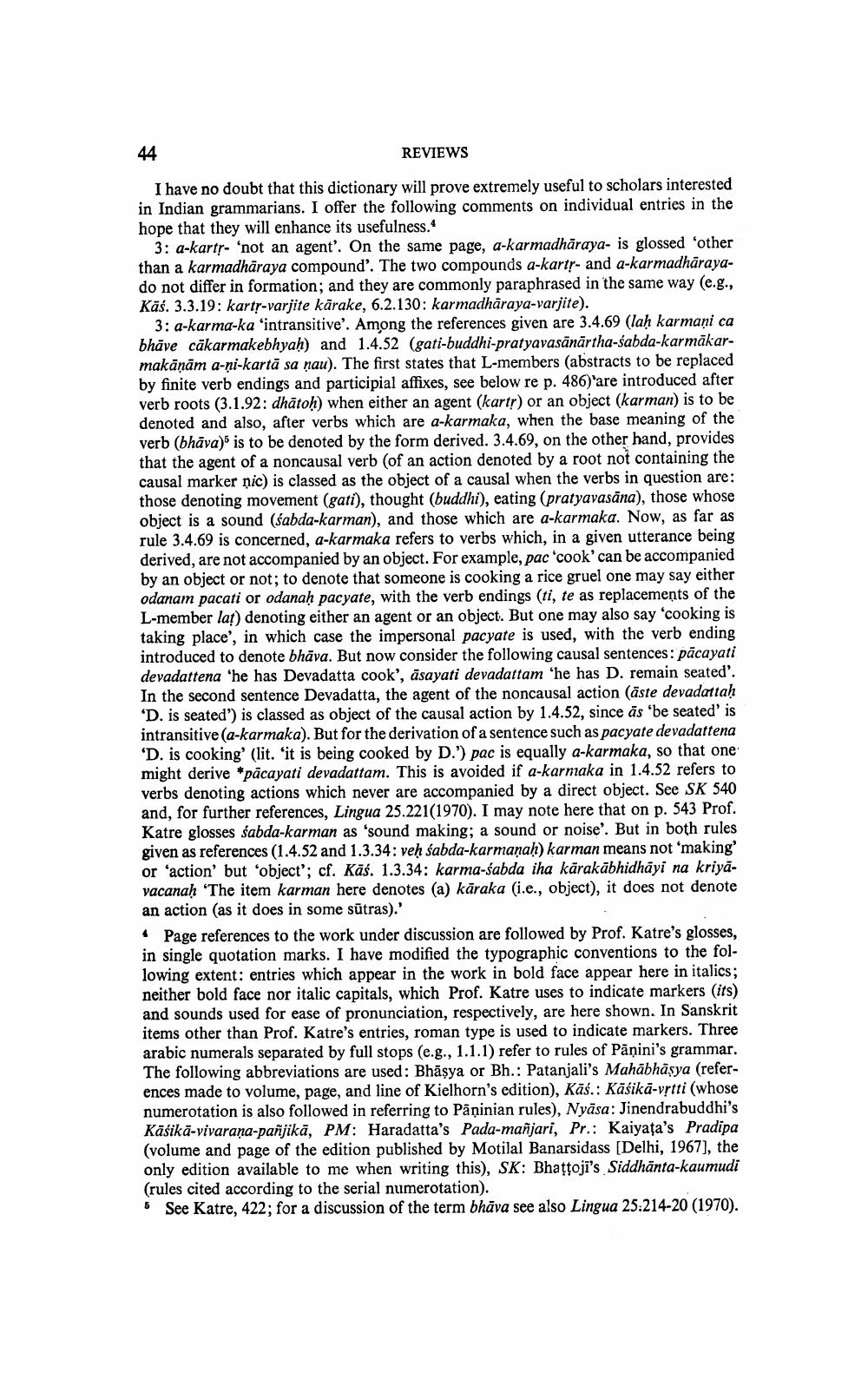Book Title: Reviews Of Different Books Author(s): Publisher: View full book textPage 2
________________ 44 REVIEWS I have no doubt that this dictionary will prove extremely useful to scholars interested in Indian grammarians. I offer the following comments on individual entries in the hope that they will enhance its usefulness. 3: a-karty- 'not an agent'. On the same page, a-karmadharaya- is glossed 'other than a karmadharaya compound'. The two compounds a-karty- and a-karmadharayado not differ in formation; and they are commonly paraphrased in the same way (e.g., Kas. 3.3.19: karti-varjite karake, 6.2.130: karmadharaya-varjite). 3: a-karma-ka 'intransitive'. Among the references given are 3.4.69 (lah karmani ca bhave cakarmakebhyah) and 1.4.52 (gati-buddhi-pratyavasanartha-sabda-karmakarmakanam a-si-karta sa nau). The first states that L-members (abstracts to be replaced by finite verb endings and participial affixes, see below re p. 486)'are introduced after verb roots (3.1.92: dhatoh) when either an agent (karty) or an object (karman) is to be denoted and also, after verbs which are a-karmaka, when the base meaning of the verb (bhava)" is to be denoted by the form derived. 3.4.69, on the other hand, provides that the agent of a noncausal verb (of an action denoted by a root not containing the causal marker nic) is classed as the object of a causal when the verbs in question are: those denoting movement (gati), thought (buddhi), eating (pratyavasana), those whose object is a sound (sabda-karman), and those which are a-karmaka. Now, as far as rule 3.4.69 is concerned, a-karmaka refers to verbs which, in a given utterance being derived, are not accompanied by an object. For example, pac 'cook' can be accompanied by an object or not; to denote that someone is cooking a rice gruel one may say either odanam pacati or odanah pacyate, with the verb endings (ti, te as replacements of the L-member lat) denoting either an agent or an object. But one may also say 'cooking is taking place', in which case the impersonal pacyate is used, with the verb ending introduced to denote bhava. But now consider the following causal sentences: pacayati devadattena "he has Devadatta cook', asayati devadattam 'he has D. remain seated'. In the second sentence Devadatta, the agent of the noncausal action (aste devadattah 'D. is seated') is classed as object of the causal action by 1.4.52, since as 'be seated' is intransitive (a-karmaka). But for the derivation of a sentence such as pacyate devadattena 'D. is cooking' (lit. 'it is being cooked by D.') pac is equally a-karmaka, so that one might derive *pacayati devadattam. This is avoided if a-karmaka in 1.4.52 refers to verbs denoting actions which never are accompanied by a direct object. See SK 540 and, for further references, Lingua 25.221(1970). I may note here that on p. 543 Prof. Katre glosses sabda-karman as 'sound making; a sound or noise'. But in both rules given as references (1.4.52 and 1.3.34: veh sabda-karmanah) karman means not 'making' or 'action' but 'object'; cf. Kas. 1.3.34: karma-sabda iha karakabhidhayi na kriyavacanah 'The item karman here denotes (a) karaka (i.e., object), it does not denote an action (as it does in some sutras).' 4 Page references to the work under discussion are followed by Prof. Katre's glosses, in single quotation marks. I have modified the typographic conventions to the following extent: entries which appear in the work in bold face appear here in italics; neither bold face nor italic capitals, which Prof. Katre uses to indicate markers (its) and sounds used for ease of pronunciation, respectively, are here shown. In Sanskrit items other than Prof. Katre's entries, roman type is used to indicate markers. Three arabic numerals separated by full stops (e.g., 1.1.1) refer to rules of Panini's grammar. The following abbreviations are used: Bhasya or Bh.: Patanjali's Mahabhasya (references made to volume, page, and line of Kielhorn's edition), Kas.: Kasika-vrtti (whose numerotation is also followed in referring to Paninian rules), Nyasa: Jinendrabuddhi's Kasika-vivarana-panjika, PM: Haradatta's Pada-manjari, Pr.: Kaiyata's Pradipa (volume and page of the edition published by Motilal Banarsidass [Delhi, 1967), the only edition available to me when writing this), SK: Bhattoji's Siddhanta-kaumudi (rules cited according to the serial numerotation). 5 See Katre, 422; for a discussion of the term bhava see also Lingua 25:2Page Navigation
1 2 3 4 5 6 7 8 9 10 11 12 13 14 15 16 17 18 19 20 21 22 ... 38
